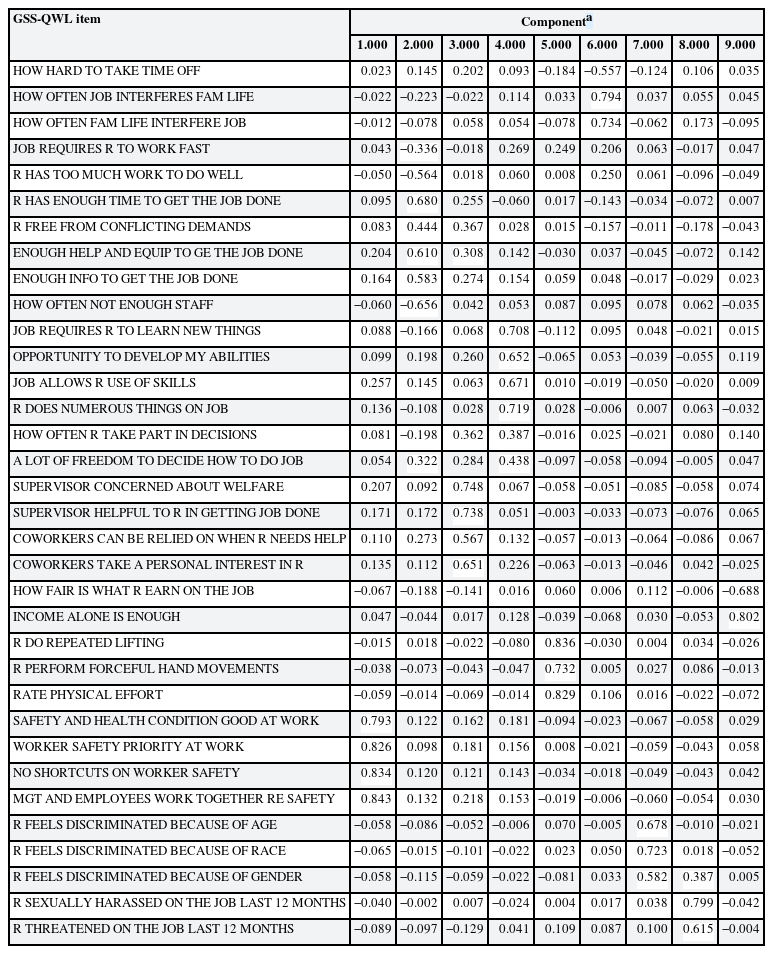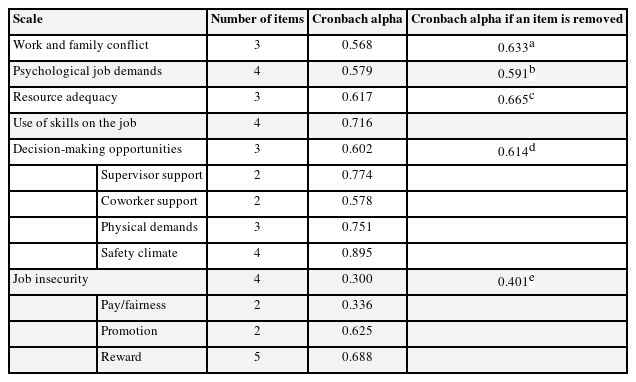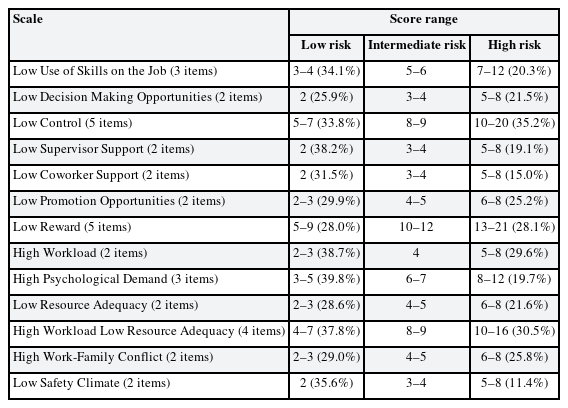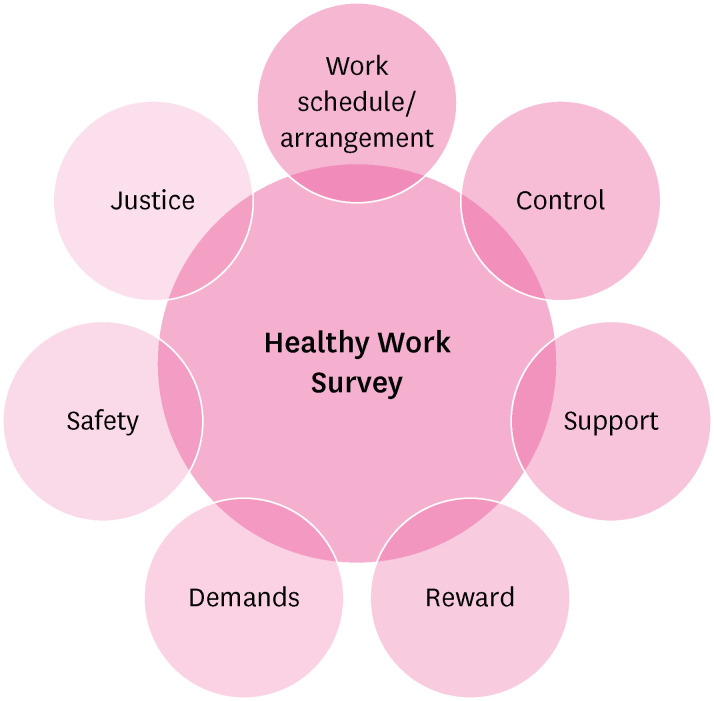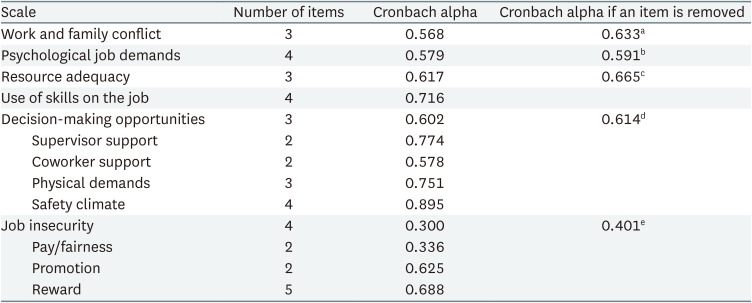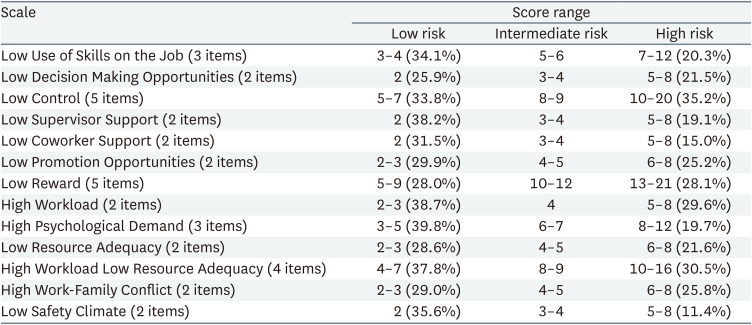Developing a short standard questionnaire for assessing work organization hazards: the Healthy Work Survey (HWS)
Article information
Abstract
Background
At present, no short standard questionnaire exists for assessing and comparing major work organization hazards in the workplaces of the United States.
Methods
We conducted a series of psychometric tests (content validity, factor analysis, differential-item functioning analysis, reliability, and concurrent validity) to validate and identify core items and scales for major work organization hazards using the data from the 2002–2014 General Social Surveys (GSSs), including the Quality of Worklife (QWL) questionnaire. In addition, an extensive literature review was undertaken to find other major work organization hazards which were not addressed in the GSS.
Results
Although the overall validity of the GSS-QWL questionnaire was satisfactory in the psychometric tests, some GSS-QWL items of work-family conflict, psychological job demands, job insecurity, use of skills on the job, and safety climate scales appeared to be weak. In the end, 33 questions (31 GSS-QWL and 2 GSS) were chosen as the least, but best validated core questions and included in a new short standard questionnaire (called the Healthy Work Survey [HWS]). And their national norms were established for comparisons. Furthermore, based on the literature review, fifteen more questions for assessing other significant work organization hazards (e.g., lack of scheduling control, emotional demands, electronic surveillance, wage theft) were included in the new questionnaire. Thus, the HWS includes 48 questions in total for assessing traditional and emerging work organization hazards, which covers seven theoretical domains: work schedule/arrangement, control, support, reward, demands, safety, and justice.
Conclusions
The HWS is a short standard questionnaire for assessing work organization hazards which can be used as a first step toward the risk management of major work organization hazards in the workplaces of the US.
BACKGROUND
Work organization hazards1 (e.g., low job control, high job demands, low social support at work, low rewards, long work hours, low safety climate, and high work and family conflicts) have negative impacts on workers’ health and safety2345678 and productivity.91011 As a first step toward the risk management of work organization hazards,1213 it is essential to have a short standard instrument for assessing the hazards (e.g., the Health & Safety Executive [HSE] Management Standards Indicator Tool of the United Kingdom14).
In the United States, there is not yet such standard instrument. In 2001, the US National Institute for Occupational Safety and Health (NIOSH) developed the Quality of Worklife (QWL) questionnaire for assessing the contemporary working life of US workers.15 The questionnaire includes about 60 items about major work organization hazards. The QWL questionnaire has been used as part of a nationwide sociological survey called the General Social Survey (GSS) since 2002.16 Thus, the QWL questionnaire has great potential to be used as a standard questionnaire for identifying and comparing the levels of major work organization hazards in the US workforce.17 However, the questionnaire is too long for routine use at the workplace. In addition, the psychometric validity of QWL items and scales of working conditions should be further tested and validated.18
On the other hand, several questionnaires based on contemporary influential work stress models (e.g., the Job Content Questionnaire19 based on the Karasek’s demand-control model20) have been widely used for workplace research projects in the US. However, the questionnaires do not allow national comparisons of the levels of work organization hazards due to a lack of recent national survey data including the questionnaires in the US. Also, both the NIOSH QWL questionnaire and several work stress model-based questionnaires are limited in assessing other important work organization hazards in a rapidly changing global economy. For example, the NIOSH QWL questionnaire and the JCQ (version 1.7) do not include items for emotional labor/demands,21 electronic surveillance,2223 and wage theft (e.g., paid less than the minimum wage).24
The purpose of the current study is to describe a whole process of developing a short standard questionnaire (called the Healthy Work Survey [HWS]) for identifying and comparing major work organization hazards in the workplaces of the US.
The HWS was designed to be utilized by employers, worker organizations, individuals, and researchers who are interested in evaluating work organization hazards in terms of workers’ health and safety, and productivity. It addresses the following needs: 1) a short questionnaire of validated items and scales that assesses major traditional and emerging work organization hazards that are applicable to a wide range of occupations and industries in the US; and 2) identifying high-risk work organization hazards at a particular company or organization by comparing aggregate scores with national norms of work organization hazards in the US workforce.
METHODS
The HWS project
It was a two-year research collaboration project among researchers at the Center for Occupational and Environmental Health, University of California Irvine, Center for Work and Health Research, Center for Social Epidemiology, and State University of New York Downstate Health Sciences University. The goal of the project was to develop a short standard questionnaire for assessing work organization hazards in the US workforce. The project started in January 2018 with a research fund from Center for Social Epidemiology (Marina Del Rey, California, USA). Dr. Choi, principal investigator of the project, led this project during 2018–2019 (for details, see below “Acknowledgements”) and as planned, the HWS was developed in December 2019 25. Although some additional work was done for getting feedback of a group of external occupational health and safety experts (n = 9) on the developed HWS and creating an online version of the HWS during 2020–2021, the current study is restricted to the work done during 2018–2019. Since the analysis of the de-identified, publicly available GSS-QWL data did not constitute human subjects research, the current study did not require an Institutional Review Board’s review.
The HWS project during 2018–2019 consisted of two main phases1725262728: Phase I – Identifying the least, but best core GSS-QWL or GSS items and scales of major work organizational hazards for the HWS and calculating their national norms; and Phase II – Adding or creating questions for other traditional or emerging major work organization hazards that are not part of the GSS-QWL or GSS, but need to be included in the HWS.
Phase I: The GSS-QWL items and scales were first examined to select the core items and scales that had been used in all five waves of the GSS in 2002, 2006, 2010, 2014, and 2018. Two non-QWL GSS items (one for labor force status and one for work hours) were also selected for analyses due to their significance.429 The core GSS-QWL and GSS items and scales were then reviewed in terms of clarity of item wording, content validity, and importance of work organization hazards according to contemporary work stress models such as the demand-control model,20 the effort-reward imbalance model,30 or organizational justice model.31 In addition, the following psychometric tests of the core items and scales were conducted in 2018 with the 2002–2014 GSS-QWL data (n = 5,796 workers; Supplementary Table 1): factor analysis, differential item functioning (DIF) analysis,32 scale reliability, and concurrent validity.
Exploratory factor analyses (extraction method: principal component analysis with varimax rotation) were undertaken with the core GSS-QWL items. In addition, we replicated the factor analyses in the following subgroups by age (up to 44 year and 45+ years), sex (men and women), race (white, black, and other), time (2002–2006 vs. 2010–2014), and occupation to test any sub-group differential construct validity of the scales.33 The following five occupational groups were tested: management, business, science, and arts occupations; service occupations; sales and office occupations; natural resources, construction, and maintenance occupations; and production, transportation, and material moving occupations.27
An item is considered to be DIF if “all respondents at a given level of the attribute measured (at a given index score) do not have equal probability of scoring positively on the item regardless of subgroup membership.”34 DIF analyses for item-level measurement equivalence of the core multi-item scales between the aforementioned subgroups were also examined with the partial gamma coefficient method.3235 Category C (moderate to large) DIF items between comparison groups was defined as items with partial gamma outside the interval (−0.31 to 0.31) and its 95% confidence interval significantly outside the interval (−0.21 to 0.21). Category A (no or negligible) and Category B (slight to moderate) DIF items were also examined.
Reliability (internal consistency) of the core multi-item scales was examined with Cronbach’s alpha statistics. Concurrent validity of the core GSS-QWL and GSS items and scales was investigated with fourteen health outcomes included in the 2002-2014 GSS-QWL data: the healthy work days measures of the US Center for Disease Control and Prevention (CDC)36 (4 items: each for general health, physical health, mental health; and unhealthy days), perceived stress at work, exhaustion, back pain, injuries, sleep problem, hypertension, diabetes, depression, obesity, and absenteeism (missing work days during the past 30 days: 1 or more vs. never). The health outcomes were all dichotomized for analyses. The concurrent validity was initially checked with Pearson and Spearman correlation coefficients and later confirmed with logistic regression analyses after controlling for age and sex.
The least, but best core GSS-QWL and GSS items for the HWS were determined with all considerations of the results of the aforementioned validation tests. National norms of the best core items/scales for the HWS were calculated in 2019 with the 2002–2018 GSS-QWL data (n = 7,189 workers) after taking into account the nature of a social complex survey of the GSS. For convenient comparisons with national statistics, scores of each multi-item scale of work organization hazards were further divided into three (low, medium, and high) risk groups using their tertiles.
Phase II: Several traditional or emerging important work organization hazards are missing in the NIOSH-QWL questionnaire and several work stress model-based questionnaires. Thus, we conducted an extensive literature review on major work organization hazards, including their assessment instruments, and if necessary, contacted external subject matter experts by e-mail for more information. In the end, for the final version of the HWS, we adopted some items from existing instruments or created some new items for the missing, but important work organization hazards.
All statistical analyses were conducted with SPSS software version 26.0 (IBM, Armonk, NY, USA).
RESULTS
Factor analyses with core GSS-QWL items
Exploratory factor analyses were initially conducted with the core 34 GSS-QWL items (Table 1) and more items (up to 50 GSS-QWL items in total) were later added and tested in subsequent factor analyses. Overall, the factor analysis of the core 34 GSS-QWL items confirmed the following nine underlying constructs of the 34 items: safety climate (4 items), psychological job demands and resource adequacy (7 items), supervisor and coworker support (4 items), job control (6 item), physical job demands (3 items), work and family conflict (3 items), discrimination (2 items), harassment (2 items), and pay/fairness (2 items) (Table 1). As expected, when more items (up to 50 items in total) of other work organization hazards (e.g., job insecurity, promotion, and respect) were added in subsequent factor analyses, more underlying constructs were identified. At the same time, in subsequent factor analyses, some general constructs (e.g., supervisor and coworker support) identified in the factor analyses with the core 34 GSS-QWL items were separated into more specific distinct constructs (e.g., supervisor support and coworker support).
However, one item of work and family conflict (“How hard is it to take time off during your work to take care of personal or family matters?”), one item of psychological job demands (“My job requires that I work very fast”), and one item of job insecurity (“How easy would it be for you to find a job with another employer with approximately the same income and fringe benefits as you have now?) were not loaded (factor loadings < 0.30) on the supposed underlying constructs in the subsequent expanded factor analyses with more numbers of items. In addition, the items of work and family conflict and psychological job demands scales also appeared to be problematic in the subgroup factor analyses, particularly, in the five occupational groups.
DIF analyses with core GSS-QWL multi-item scales
There were no moderate to large DIF items of the following multi-item GSS-QWL scales: decision making opportunities (a subscale of job control), resource adequacy, work and family conflict, supervisor and coworker support, and promotion. However, as in the factor analyses, some items of the psychological job demands and job insecurity were identified as moderate to large DIF items, particularly between occupational groups. In addition, one item of use of skills on the job (a subscale of job control: “My job requires that I keep learning new things”) and two items of safety climate (“Where I work, employees and management work together to ensure the safest possible working conditions” and “The safety and health conditions where I work are good”) turned out to be moderate to large DIF items between occupational or racial groups (Table 2).
Reliability of core GSS-QWL multi-item scales
Table 2 shows Cronbach’s alpha values of some GSS-QWL multi-item scales. The alpha values of use of skills on the job, supervisor support, coworker support, physical demands, safety climate, promotion, and reward scales were satisfactory, given their relatively smaller numbers of items. However, the alpha values of job insecurity and pay/fairness was very low (close to 0.30). In addition, when an item was removed, the alpha values in the following scales increased moderately (≥ 0.05) (Table 3): work and family conflict (“How hard is it to take time off during your work to take care of personal or family matters?”), resource adequacy (“How often are there not enough people or staff to get all the work done?”), and job insecurity (“How easy would it be for you to find a job with another employer with approximately the same income and fringe benefits as you have now?”).
Concurrent validity of core GSS-QWL and GSS items
The core QWL-QWL and GSS items and scales were first examined with both Pearson and Spearman correlation coefficients in relations to the fourteen health outcomes included in the 2002-2014 GSS-QWL data. The directions of the correlations were consistent with our expectations. For example, low job control, high psychological job demands, high strain (a ratio of psychological job demands to job control), job insecurity, and low rewards were all positively correlated with depression, hypertension, and absenteeism. The results remained to be very similar in complex survey design based multivariate logistic regression analyses after controlling for age and sex. In addition, comparisons of the correlations between some full-scales with and without psychometrically weak item(s) were made in relations to the health outcomes. For instance, the full scale of work and family conflict (3 items) and the reduced scale of work and family conflict (2 items; without the following psychometrically weak item: “How hard is it to take time off during your work to take care of personal or family matters?”) were compared in terms of correlations with the four healthy work days measures (Table 4). The odds ratios of the full and reduced scales of work and family conflict for each of the four healthy work days measures after controlling for age and sex were very similar to each other.
National norms of 33 GSS-QWL and GSS items and scales included in the HWS
With all considerations of the results of the psychometric tests and their theoretical relevance and importance in work stress and health research, thirty-three (31 GSS-QWL and 2 GSS) items of work organization hazards (Supplementary Data 1) were selected to be included in the HWS. For national norms of the thirty-three items, the response distribution table of each item was created using the 2002–2018 GSS-QWL data (not shown here, available on request to the authors). Table 5 shows the low-, intermediate-, and high-risk score ranges of GSS-QWL multiple-item scales included in the HWS, based on the 2002-2018 GSS-QWL data.
New fifteen items of traditional or emerging work organization hazards included in the HWS
Based on an extensive literature review on major work organization hazards and their measurement instruments, new fifteen non-GSS items of traditional or emerging work organization hazards were included in the HWS (Supplementary Data 1): scheduling control (2 items), emotional demands (2 items), electronic surveillance (1 item), exposure to toxic chemicals (1 items), safety hazard (1 item), workplace physical violence (1 item), bullying (1 item), low wage (1 item), and wage theft (1 item), organizational justice (1 item), union (1 item), paid sick leave (1 item), and medical insurance (1 item). Out of 15 non-GSS items, 11 items came from existing validated instruments, 3 items were newly created, but simple in content for asking about existence of union and workers’ benefits, and 1 item was suggested by an external expert (see below).
Two items for scheduling control, work time arrangement (flextime)37 and schedule changes/advanced notice, were selected from the 2015 European working condition survey questionnaire.38 The items were also used in the 2015 American working condition survey.39 Two items for emotional demands came from the Copenhagen Psychosocial Questionnaire (COPSOQ) II.40 A single item for electronic surveillance2223 was suggested by an expert at the NIOSH with information that the item could be included in a future national survey. Exposure to chemical and safety hazards cannot be ignored as workplace stressors.12 Thus, two items for those hazards were adopted from the 2010 National Health Interview Survey-Occupational Health Supplement41 and the 1977 Quality of Employee Survey.42 Items about workplace physical violence and bullying were selected from the COPSOQ II and a 2017 report of the Workplace Bullying Institute,43 respectively. The items for low wage (two-thirds of the median hourly wage rate in US workers),44 wage theft,24 and organizational justice (procedural justice)45 were added based on the literature review. Items for union,46 paid sick leave,47 and medical insurance48 were created due to their particular importance in the US where union density is very low and neither federal legal requirements for paid sick leave nor universal healthcare systems exist.
Structures of the HWS
In summary, the HWS includes 48 questions for assessing important traditional and emerging work organization hazards: 31 questions from the GSS-QWL and 2 questions from the GSS and new 15 non-GSS questions mostly from existing validated instruments (Table 6, Supplementary Data 1). The 48 HWS items are conceptually summarized into seven theoretical domains of work organization hazards (Fig. 1): Work schedule/Arrangement, 8 items (W1–W8); Control, 6 items (W9–W14); Support, 4 items (W15–W18); Reward, 5 items (W19–W23); Demands, 11 items (W24–W34); Safety, 5 items (W35–W39); and Justice, 9 items (W40–W48). In addition, in supplementary sections, the HWS also includes 17 questions for health outcomes (H1–H17: 14 questions from the GSS, 2 questions from the Work Limitations Questionnaire,49 and 1 item for stress at home) and 10 questions for sociodemographic characteristics (S1–S10) (for details, see Supplementary Data 1).
DISCUSSION
In this paper, we presented a new short, standard questionnaire for identifying and comparing major work organization hazards in the workplace of the US. The HWS was developed through a series of rigorous psychometric tests of core GSS-QWL and GSS items of major work organization hazards with consideration of their theoretical relevance and importance in work and health research, and an extensive literature review of other important work organization hazards and their instruments.
We think that the HWS has two major merits over other instruments for assessing work organization hazards particularly in the US workforce. First, as intended, the HWS is relatively short (48 items in total) in length while addressing various major traditional and emerging work organization hazards of seven theoretical domains. For the HWS, we were able to select only almost half out of 60 items in the original NIOSH QWL questionnaire through rigorous systematic validation tests. This significant reduction in the number of items created a room for 15 items about other important work organization hazards in the HWS, which are not assessed with the QWL questionnaire. In addition, we expect that the HWS would be completed within 10 minutes in most cases. Second, it enables the users to compare their aggregated scores (at least, for the 33 GSS-QWL/GSS items and scales) at a particular company or organization with national norms of work organization hazards in the US workforce. Thus, the users will be able to not only asses work organization hazards, but also identify high-risk work organization hazards at their organizations based on the comparison with national norms. Such comparison will help all workplace stakeholders better understand the levels of their work organization hazards from a national perspective, which may facilitate their concerted efforts to address their high-risk work organization hazards. The HSE Management Standards Indicator Tool of the United Kingdom (35 items of six theoretical domains in total) is shorter in length than the HWS; however, in contrast with the HWS, it neither has national norms for comparison, nor includes questions about electronic surveillance, safety climate, chemical and physical hazards, low income, and wage theft.
On the other hand, this study is one of the few comprehensive psychometric studies of the NIOSH QWL questionnaire.18 Although the overall validity of the GSS-QWL questionnaire was good, this study indicates that some GSS-QWL items of work-family conflict, psychological job demands, job insecurity, use of skills on the job, and safety climate scales are psychometrically weak. Although the weak items were not selected for the HWS, their validity needs to be further tested and confirmed in future studies. Also, the current study has a strength of providing a detailed methodology of creating a short, standard questionnaire for assessing major work organization hazards. Furthermore, our literature review in the current study demonstrated that several important work organization hazards are not currently addressed in the NIOSH QWL questionnaire and influential work stress model-based questionnaires, for example, schedule control, emotional demands, electronic surveillance, and wage theft. We hope that the HWS facilitates more future studies on those relatively understudied, but increasingly important work organization hazards.
There are two limitations in the current study. First, the validity of the HWS as a whole, including the non-GSS items, should be further tested and evaluated in a wide range of occupations and industries. Nonetheless, it should be reminded that most of the 15 non-GSS items came from existing validated instruments and some items were created, but very simple in content. Furthermore, the developed HWS was additionally reviewed by a group of experts during 2020–2021 and no significant weaknesses were identified. Second, at present, the national norms of the HWS are established only for the 31 GSS-QWL and 2 GSS items using the 2002–2018 GSS-QWL data, but not for the 15 non-GSS items of work organization hazards. Thus, the national norms of the non-GSS items remains to be established in the future. Also, the current national norms of the 31 GSS-QWL and 2 GSS items needs to be continuously updated with future GSS-QWL data.
CONCLUSIONS
We developed a new short, standard questionnaire for identifying and comparing major work organization hazards in the workplace of the US. The developed questionnaire, the HWS includes 48 questions (31 GSS-QWL, 2 GSS, and 15 non-GSS items) in total for assessing traditional and emerging work organization hazards, which covers seven theoretical domains: work schedule/arrangement, control, support, reward, demands, safety, and justice. We believe that the HWS, if widely accepted and used, has great potential to be an essential tool for the risk management of traditional and emerging major work organization hazards in the workplaces of the US.
ACKNOWLEDGMENTS
We thank Dr. Naomi Swanson (National Institute for Occupational Safety and Health; NIOSH) for providing a copy of the Quality of Worklife (QWL) questionnaire included in the 2018 General Social Survey. We also thanks the following researchers for providing information on instruments of some major work organization hazards or health outcomes which are not addressed in the QWL questionnaire: Drs. Paul Landsbergis (State University of New York Downstate Health Sciences University), Marnie Dobson (University of California, Irvine), Peter Schnall (Center for Social Epidemiology), Pouran Faghri (University of Connecticut), Meredith Minkler (University of California, Berkeley), Isabel Garcia (University of California, Los Angeles), Toni Alterman (NIOSH), Gary Namie (Workplace Bullying Institute), and Hermann Burr (Federal Institute for Occupational Safety and Health, BAuA in Germany).
Notes
Funding: This study is funded by the Center for Social Epidemiology (Marina Del Rey, CA, USA) and the Center for Work and Health Research (Irvine, CA, USA).
Competing interests: The authors declare that they have no competing interests.
Author Contributions:
Conceptualization: Choi B.
Data curation: Choi B, Seo Y.
Formal analysis: Choi B, Seo Y.
Funding acquisition: Choi B.
Investigation: Choi B, Seo Y.
Methodology: Choi B.
Software: Choi B.
Writing - original draft: Choi B.
Writing - review & editing: Choi B, Seo Y.
Abbreviations
CDC
Center for Disease Control and Prevention
COPSOQ
Copenhagen Psychosocial Questionnaire
DIF
differential item functioning
GSS
General Social Survey
GSS-QWL
General Social Survey-Quality of Worklife
HSE
Health & Safety Executive
HWS
Healthy Work Survey
NIOSH
National Institute for Occupational Safety and Health
QWL
Quality of Worklife
References
SUPPLEMENTARY MATERIALS
Supplementary Table 1
Sociodemographic characteristics of 5,796 workers in the 2002–2014 GSS-QWL data
Supplementary Data 1
The Healthy Work Survey

